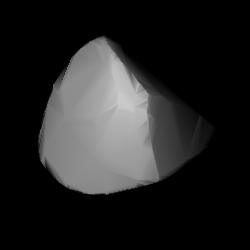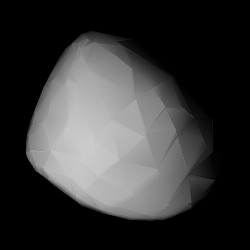
2985 Shakespeare (prov. designation: 1983 TV1) is a stony Koronian asteroid from the outer region of the asteroid belt. It was discovered on 12 October 1983, by American astronomer Edward Bowell at Lowell's Anderson Mesa Station near Flagstaff, Arizona, and later named after William Shakespeare. The presumed S-type asteroid has a rotation period of 6.1 hours and measures approximately 10 kilometers (6.2 miles) in diameter.
1762 Russell, provisional designation 1953 TZ, is a stony Koronian asteroid from the outer regions of the asteroid belt, approximately 16 kilometers in diameter. It was discovered by the Indiana Asteroid Program at Goethe Link Observatory near Brooklyn, Indiana, on 8 October 1953. The asteroid was named after American astronomer Henry Norris Russell.
1955 McMath, provisional designation 1963 SR, is a stony Koronis asteroid from the outer region of the asteroid belt, approximately 10 kilometers in diameter.

1132 Hollandia, provisional designation 1929 RB1, is a stony asteroid from the middle region of the asteroid belt, approximately 27 kilometers in diameter. It was discovered on 13 September 1929, by Dutch astronomer Hendrik van Gent at Leiden Southern Station, annex to the Johannesburg Observatory in South Africa. It was named for the region Holland in the Netherlands.
1213 Algeria, provisional designation 1931 XD, is a carbonaceous asteroid from the outer region of the asteroid belt, approximately 32 kilometers in diameter. Discovered by Guy Reiss at Algiers Observatory in 1931, it was named after the North African country of Algeria.

1635 Bohrmann, provisional designation 1924 QW, is a stony Koronian asteroid from the outer region of the asteroid belt, approximately 17 kilometers in diameter. It was discovered on 7 March 1924, by German astronomer Karl Reinmuth at Heidelberg Observatory in southern Germany, and named for astronomer Alfred Bohrmann.

1848 Delvaux is a stony Koronis asteroid from the outer region of the asteroid belt, approximately 17 kilometers in diameter. It was discovered on 18 August 1933, by Belgian astronomer Eugène Delporte at the Royal Observatory of Belgium in Uccle, Belgium. It was later named after astronomer Georges Roland's sister-in-law.

1672 Gezelle, provisional designation 1935 BD, is a carbonaceous asteroid from the outer region of the asteroid belt, approximately 27 kilometers in diameter. It was discovered on 29 January 1935, by Belgian astronomer Eugène Delporte at Royal Observatory of Belgium in Uccle, Belgium. It was later named after Flemish poet and Roman Catholic priest Guido Gezelle.
1995 Hajek, provisional designation 1971 UP1, is a metallic asteroid from the middle region of the asteroid belt, approximately 13 kilometers in diameter.
5333 Kanaya, provisional designation 1990 UH, is a carbonaceous asteroid from the inner regions of the asteroid belt, approximately 14 kilometers in diameter.
2187 La Silla, provisionally designated 1976 UH, is a stony Eunomia asteroid from the middle region of the asteroid belt, approximately 12 kilometers in diameter.
6025 Naotosato, provisional designation 1992 YA3, is an Eoan asteroid from the outer region of the asteroid belt, approximately 19 kilometers in diameter. It was discovered on 30 December 1992, by Japanese astronomer Takeshi Urata at the Nihondaira Observatory in Oohira, Japan. The asteroid was named after Japanese amateur astronomer Naoto Satō.
For other uses, see Steel (disambiguation).
1847 Stobbe, provisional designation A916 CA, is an asteroid from the middle region of the asteroid belt, approximately 23 kilometers in diameter.
2013 Tucapel, provisional designation 1971 UH4, is an eccentric Florian asteroid from the inner regions of the asteroid belt, approximately 11 kilometers in diameter. It was discovered on 22 October 1971, by the University of Chile's National Astronomical Observatory at Cerro El Roble Astronomical Station. It was named for one of the indigenous Mapuche chiefs.

3962 Valyaev is a dark Themistian asteroid from the outer region of the asteroid belt. The presumed C-type asteroid has a rotation period of 16.4 hours and measures approximately 15 kilometers in diameter. It was discovered on 8 February 1967, by Russian astronomer Tamara Smirnova at Nauchnyj on the Crimean peninsula, and later named after Russian astronomer Valerij Valyaev.

1336 Zeelandia, provisional designation 1934 RW, is a stony Koronian asteroid from the outer regions of the asteroid belt, approximately 21 kilometers in diameter. It was discovered on 9 September 1934, by Dutch astronomer Hendrik van Gent at the Union Observatory in Johannesburg, South Africa. The asteroid was named for the Dutch province of Zeeland.

1289 Kutaïssi is a stony Koronian asteroid from the outer region of the asteroid belt. Discovered by Grigory Neujmin at Simeiz Observatory in 1933, it was later named after the Georgian city of Kutaisi. The S-type asteroid has a rotation period of 3.6 hours and measures approximately 22 kilometers in diameter.
2123 Vltava, provisional designation 1973 SL2, is a stony Koronian asteroid from the outer region of the asteroid belt, approximately 15 kilometers in diameter. It was discovered on 22 September 1973, by Soviet–Russian astronomer Nikolai Chernykh at the Crimean Astrophysical Observatory on the Crimean peninsula in Nauchnyj. It is named for the river Vltava (Moldau).
12564 Ikeller, provisional designation 1998 SO49, is a stony Koronian asteroid from the outer region of the asteroid belt, approximately 5 kilometers in diameter.








